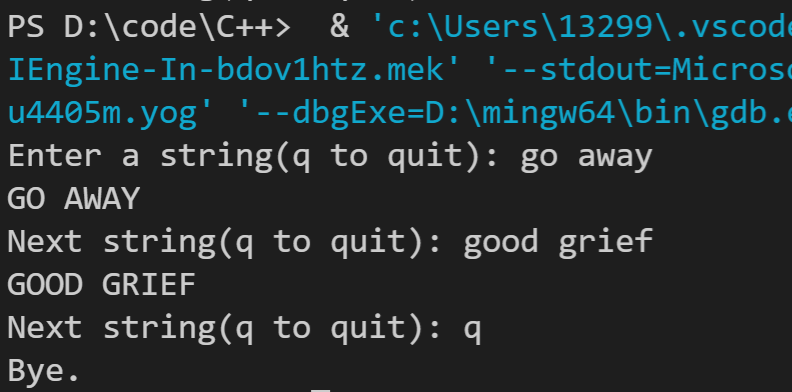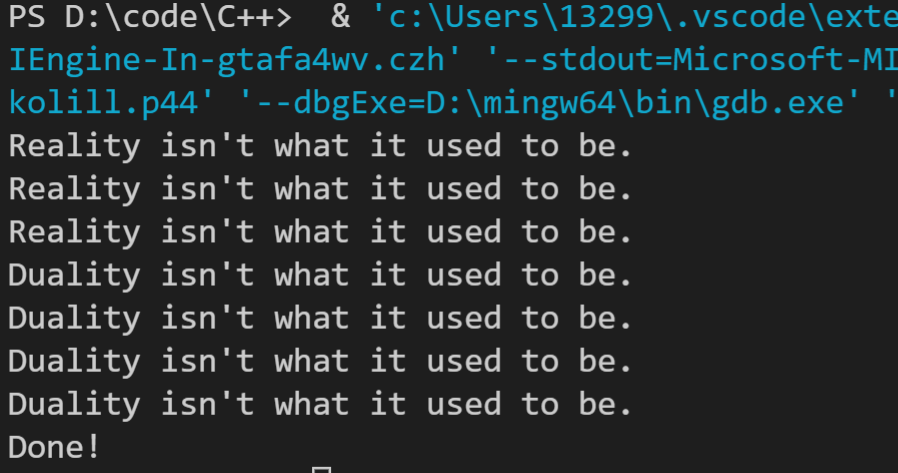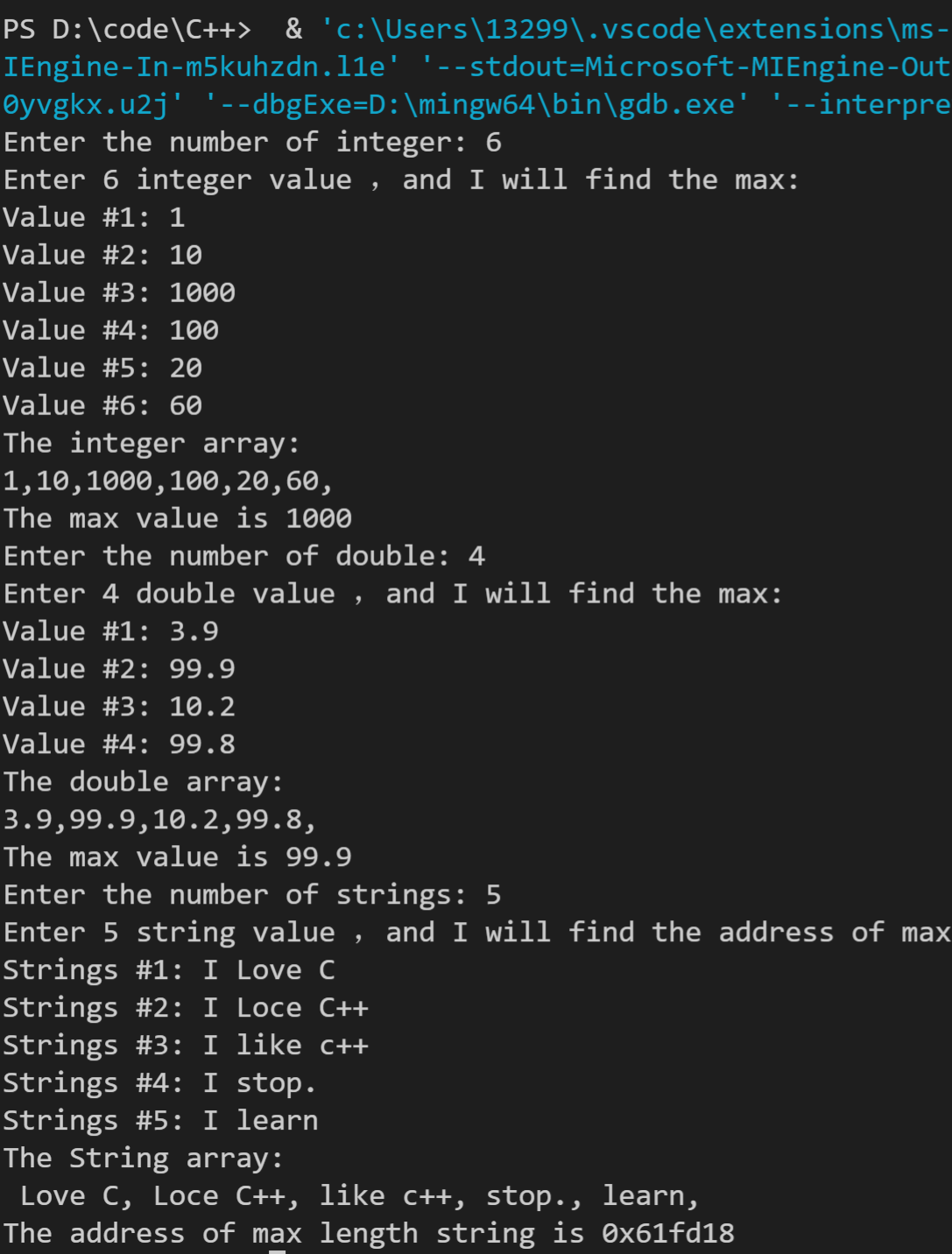C++ Primier Plus(第六版) 第八章 函数探幽编程练习答案
- 1. 编写通常接受一个参数(字符串的地址),并打印该字符串的函数。然后,如果提供了第二个参数(int类型),且该参数不为0,则该函数打印字符串的次数将为该函数被调用的次数(注意,字符串打印的次数不等于第二个参数的值,而等于函数被调用的次数)。是的,这是一个非常可笑的函数,但它让您能够使用本章介绍的一些技术,在一个简单的程序中使用该函数,以演示该函数是如何工作的。
- 2. CandyBar的结构有3个成员。第一个成员存储candy bar的品牌名称;第二个存储candy bar的重量(可能有小数);第三个存储candy bar的热量(整数)。请编写一个程序,它使用一个这样的函数,即将CandyBar的引用、char指针、double和int作为参数,并用最后3个值设置相应的结构成员。最后3个参数的默认值分别为"Millenium Munch"、2.85和350。另外,该程序还包含一个以CandyBar引用为参数,并显示结构内容的函数。请尽可能使用const。
- 3. 编写一个函数,它接受一个指向string对象的引用作为参数,并将该string对象的内容转换为大写,为此可使用表6.4描述的函数toupper()。然后编写一个程序,它通过一个循环让您能够用不同的输入来测试这个函数,该程序的运行情况如下:
- 4. 下面是一个程序框架:
- 5. 编写模板函数max5(),它将一个包含5个T类型元素的数组作为参数,并返回数组中最大的元素(由于长度固定,因此可以在循环中使用硬编码,而不必通过参数来传递)。在一个程序中使用该函数,将T替换为一个包含5个int值的数组和一个包含5个double值的数组,以测试该函数。
- 6. 编写模板函数maxn(),它将由一个T类型元素组成的数组和一个表示数组元素数目的整数作为参数,并返回数组中最大的元素。在程序中对他进行测试,该程序使用一个包含6个int元素的数组和一个包含4个double元素的数组来调用该函数。程序还包含一个具体化,它将char指针数组和数组中的指针数量作为参数,并返回最长的字符串的地址。如果有多个这样的字符串,则返回其中第一个字符串的地址。使用由5个字符串指针组成的数组来测试该具体化。
- 7. 修改程序清单8.14,使其使用两个名为SumArray()的模板函数来返回数组元素的综合,而不是显示数组的内容。程序应显示thing的总和以及所有debt的总和。
1. 编写通常接受一个参数(字符串的地址),并打印该字符串的函数。然后,如果提供了第二个参数(int类型),且该参数不为0,则该函数打印字符串的次数将为该函数被调用的次数(注意,字符串打印的次数不等于第二个参数的值,而等于函数被调用的次数)。是的,这是一个非常可笑的函数,但它让您能够使用本章介绍的一些技术,在一个简单的程序中使用该函数,以演示该函数是如何工作的。
本题首先需要设置一个全局变量,统计showstr()函数调用了几次,然后使用默认参数的函数,默认参数的显示函数用if来设置,代码如下:
// ex1.cpp -- using default argument
#include<iostream>
int count = 0; // count the times of call showstr() function
void showstr(const char * s, int n = 0);
int main()
{
const char * ps = {"I like C++!"};
for(int j = 0; j < 5; j++)
{
showstr(ps);
showstr(ps,1);
}
return 0;
}
void showstr(const char * s, int n)
{
using std::cout;
++count;
if(n == 0)
cout << s << "\n";
else
{
for(int i = 0; i < count; i++)
cout << s << " ";
cout << "\n";
}
}
运行结果如下:

2. CandyBar的结构有3个成员。第一个成员存储candy bar的品牌名称;第二个存储candy bar的重量(可能有小数);第三个存储candy bar的热量(整数)。请编写一个程序,它使用一个这样的函数,即将CandyBar的引用、char指针、double和int作为参数,并用最后3个值设置相应的结构成员。最后3个参数的默认值分别为"Millenium Munch"、2.85和350。另外,该程序还包含一个以CandyBar引用为参数,并显示结构内容的函数。请尽可能使用const。
本题考查的还是默认参数函数的声明定义和调用,注意默认参数从右到左的顺序。
代码如下:
// ex2.cpp -- using default argument and reference of structure
#include<iostream>
#include<cstring>
const int Size = 20;
struct CandyBar
{
char name[Size];
double weight;
int carloris;
};
void fill(CandyBar &, char * n = "Millennium Munch", double w = 2.85, int c = 350);
void show(const CandyBar &);
int main()
{
using namespace std;
char *cname = new char[Size];
double cweight;
int ccaloris;
CandyBar cbs;
fill(cbs);
show(cbs);
cout << "Enter the name of CandyBar: ";
cin.getline(cname,Size);
cout << "After input name:\n";
fill(cbs, cname);
show(cbs);
cout << "Enter the weight of CandyBar: ";
cin >> cweight;
cin.get();
cout << "After input weight:\n";
fill(cbs, cname, cweight);
show(cbs);
cout << "Enter the weight of CandyBar: ";
cin >> ccaloris;
cin.get();
cout << "After input caloris:\n";
fill(cbs, cname, cweight, ccaloris);
show(cbs);
return 0;
}
void fill(CandyBar & cb, char * n, double w, int c)
{
strcpy(cb.name,n);
cb.weight = w;
cb.carloris = c;
}
void show(const CandyBar &cb)
{
using std::cout;
cout << "Name: " << cb.name << "\tWeight: " << cb.weight;
cout << "\tCarloris: " << cb.carloris << "\n";
}
运行结果如下:

3. 编写一个函数,它接受一个指向string对象的引用作为参数,并将该string对象的内容转换为大写,为此可使用表6.4描述的函数toupper()。然后编写一个程序,它通过一个循环让您能够用不同的输入来测试这个函数,该程序的运行情况如下:
Enter a string(q to quit): go away
GO AWAY
Next string(q to quit): good grief!
GOOD GRIEF
Next string(q to quit):q
Bye.
本题使用toupper()会很简单,使用toupper()函数需要添加头文件cstdlib。不适用也可以,通过if语句和ASCKII码转换来进行,笔者使用了toupper函数。
代码如下:
// ex3.cpp -- convert the a... to A...
#include<iostream>
#include<cstdlib>
#include<string>
using namespace std;
void str_toupper(string & s);
int main()
{
string s;
cout << "Enter a string(q to quit): ";
getline(cin,s);
while(s != "q")
{
str_toupper(s);
cout << s << endl;
cout << "Next string(q to quit): ";
getline(cin,s);
}
cout << "Bye.\n";
return 0;
}
void str_toupper(string & s)
{
int i = 0;
while(s[i] != '\0')
{
s[i] = toupper(s[i]);
i++;
}
}
运行结果如下:

4. 下面是一个程序框架:
#include<iostream>
using namespace std;
#include<cstring>
struct stringy
{
char * str;
int ct;
};
// prototypes for set(), show() and show() go here
int main()
{
string beany;
char testing[] = "Reality isn't what it used to be.";
set(beany, testing); // first argument is a reference,
// allocates space to hold copy of testing,
// sets str memebr of beany to point to the
// new block, copies testing to new block,
// and sets ct membet of beany
show(beany); // prints member string once
show(beany, 2); // prints member string twice
testing[0] = 'D';
testing[1] = 'u';
show(testing); // prints testing string once
show(testing, 3); // prints testing string thrice
show("Done!");
return 0;
}
请提供其中描述的函数和原型,从而完成该程序。注意,应有两个show函数,每个都使用默认参数。请尽可能使用const参数。set()使用new分配足够的空间来存储指定的字符串。这里使用的技术与设计和实现类时使用的类似。(可能还必须修改头文件的名称,删除using编译指令,这取决于所用的编译器)
本题涉及到引用结构函数的声明和定义,以及重载带默认参数的函数的声明和定义。
代码如下:
// ex4.cpp -- write the rest procedures
#include<iostream>
using namespace std;
#include<cstring>
struct stringy
{
char * str;
int ct;
};
// prototypes for set(), show() and show() go here
void set(stringy &,char []);
void show(const stringy &, int n = 1);
void show(const char [], int n = 1);
int main()
{
stringy beany;
char testing[] = "Reality isn't what it used to be.";
set(beany, testing); // first argument is a reference,
// allocates space to hold copy of testing,
// sets str memebr of beany to point to the
// new block, copies testing to new block,
// and sets ct member of beany
show(beany); // prints member string once
show(beany, 2); // prints member string twice
testing[0] = 'D';
testing[1] = 'u';
show(testing); // prints testing string once
show(testing, 3); // prints testing string thrice
show("Done!");
return 0;
}
void set(stringy & s,char cs[])
{
s.ct = strlen(cs);
s.str = new char[s.ct + 1];
strcpy(s.str,cs);
}
void show(const stringy & s, int n)
{
for(int i = 0; i < n; i++)
cout << s.str << endl;
}
void show(const char cs[], int n)
{
for(int i = 0; i < n; i++)
cout << cs << endl;
}
运行结果如下:

5. 编写模板函数max5(),它将一个包含5个T类型元素的数组作为参数,并返回数组中最大的元素(由于长度固定,因此可以在循环中使用硬编码,而不必通过参数来传递)。在一个程序中使用该函数,将T替换为一个包含5个int值的数组和一个包含5个double值的数组,以测试该函数。
本题考查的是模板函数的知识点,在最开始定义一个全局常变量记录数组的大小为5,然后创建模板函数,笔者使用了?:运算符。
代码如下:
// ex5.cpp -- using template funtion to find the max
#include<iostream>
const int Size = 5;
template<class T>
T max5(T[]);
template<class T>
void show(T[]);
int main()
{
using namespace std;
int iar[Size];
double dar[Size];
// integer
cout << "Enter five integer,and I will find the max:\n";
for(int i = 0; i < Size; i++)
{
cout << "Integer #" << i + 1 << ": ";
cin >> iar[i];
}
cout << "The integer array:\n";
show(iar);
int imax = max5(iar);
cout << "The max value is " << imax << endl;
// double
cout << "Enter five double values,and I will find the max:\n";
for(int i = 0; i < Size; i++)
{
cout << "Value #" << i + 1 << ": ";
cin >> dar[i];
}
cout << "The double array:\n";
show(dar);
double dmax = max5(dar);
cout << "The max value is " << dmax << endl;
return 0;
}
template<class T>
T max5(T arr[])
{
T max = arr[0];
for(int i = 0; i < Size; i++)
max = max > arr[i] ? max : arr[i];
return max;
}
template<class T>
void show(T arr[])
{
using std::cout;
for(int i = 0; i < Size; i++)
cout << arr[i] << " ";
cout << "\n";
}
运行结果如下:

6. 编写模板函数maxn(),它将由一个T类型元素组成的数组和一个表示数组元素数目的整数作为参数,并返回数组中最大的元素。在程序中对他进行测试,该程序使用一个包含6个int元素的数组和一个包含4个double元素的数组来调用该函数。程序还包含一个具体化,它将char指针数组和数组中的指针数量作为参数,并返回最长的字符串的地址。如果有多个这样的字符串,则返回其中第一个字符串的地址。使用由5个字符串指针组成的数组来测试该具体化。
本题考查的是模板函数和模板函数的具体化,本题的模板函数和具体化都没有问题,在写测试的过程中主函数出现了问题,分配内存空间,创造指针数组存贮字符串的时候没有给字符串分配空间,分配空间后忘记了释放。
代码如下:
// ex6.cpp -- using template function and explicit template function to find max
#include<iostream>
#include<cstring>
template<class T>
T maxn(T[], int n);
template<>
char * maxn<char *>(char *ps[], int n);
template<class T>
void show(T[], int size);
int main()
{
using namespace std;
int size;
// test integer
cout << "Enter the number of integer: ";
cin >> size;
int iar[size];
cout << "Enter "<< size <<" integer value ,and I will find the max:\n";
for(int i = 0; i < size; i++)
{
cout << "Value #" << i + 1 << ": ";
cin >> iar[i];
}
cout << "The integer array:\n";
show(iar,size);
int imax = maxn(iar,size);
cout << "The max value is " << imax << endl;
// test double
cout << "Enter the number of double: ";
cin >> size;
double dar[size];
cout << "Enter "<< size <<" double value ,and I will find the max:\n";
for(int i = 0; i < size; i++)
{
cout << "Value #" << i + 1 << ": ";
cin >> dar[i];
}
cout << "The double array:\n";
show(dar,size);
double dmax = maxn(dar,size);
cout << "The max value is " << dmax << endl;
// test char *
char temp[100];
cout << "Enter the number of strings: ";
cin >> size;
char * ps[size];
cout << "Enter "<< size <<" string value ,and I will find the address of max:\n";
for(int i = 0; i < size; i++)
{
cout << "Strings #" << i + 1 << ": ";
while(cin.get() == '\n')
continue;
cin.getline(temp,100);
ps[i] = new char[strlen(temp)+1]; // is must else will cause the mistake,need to distribute RAM
strcpy(ps[i],temp);
}
cout << "The String array:\n";
show(ps,size);
char * psmax = maxn(ps,size);
cout << "The address of max length string is " << &psmax << endl;
for(int i = 0; i < size; i++)
delete [] ps[i];
return 0;
}
template<class T>
T maxn(T arr[], int n)
{
T max = arr[0];
for(int i = 0; i < n; i++)
max = max > arr[i] ? max : arr[i];
return max;
}
template<>
char * maxn<char *>(char *ps[], int n)
{
char * max = ps[0];
for(int i = 0; i < n; i++)
max = strlen(max) >= strlen(ps[i]) ? max : ps[i];
return max;
}
template<class T>
void show(T arr[],int n)
{
using std::cout;
for(int i = 0; i < n; i++)
cout << arr[i] << ",";
cout << "\n";
}
测试结果如下:

7. 修改程序清单8.14,使其使用两个名为SumArray()的模板函数来返回数组元素的综合,而不是显示数组的内容。程序应显示thing的总和以及所有debt的总和。
本题修改函数模板,再修改时,会遇到很多错误,修改时按照先原型,在定义,最后调用的方式修改。
代码如下:
// ex7.cpp -- using template function to calculate sum
#include<iostream>
template<typename T>
T SumArray(T[], int);
template<typename T>
T SumArray(T* arr[], int n);
struct debts
{
char name[50];
double amount;
};
int main()
{
using namespace std;
int things[6] = {13, 31, 103, 301, 310, 130};
struct debts mr_E[3] =
{
{"Ima Wolfe", 2400.0},
{"Ura Foxe", 1300.0},
{"Iby Stout", 1900.0}
};
double *pd[3];
for(int i = 0; i < 3; i++)
pd[i] = &mr_E[i].amount;
cout << "The sum of Mr.E's things: ";
cout << SumArray(things,6) << endl;
cout << "The sum of Mr.E's debts: ";
cout << SumArray(pd,3) << endl;
return 0;
}
template<typename T>
T SumArray(T arr[], int n)
{
using std::cout;
T sum = 0;
cout << "template A\n";
for(int i = 0; i < n; i++)
sum += arr[i];
return sum;
}
template<typename T>
T SumArray(T* arr[], int n)
{
using std::cout;
T sum = 0;
cout << "template B\n";
for(int i = 0; i < n; i++)
sum += *arr[i];
return sum;
}
运行结果如下:


